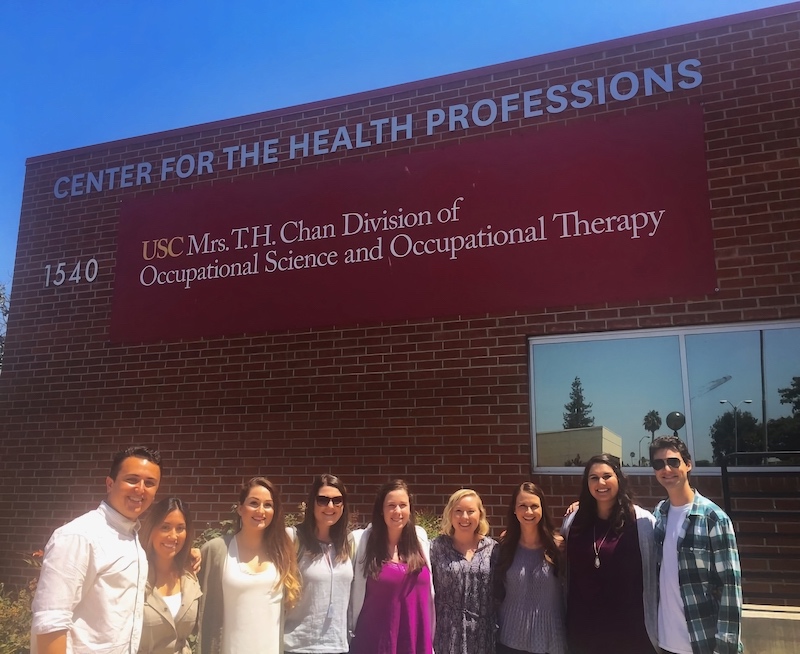Student Blog
Life Hacks

Back to School Excitement ⟩
August 30, 2017, by Caroline
Life Hacks
I love the excitement that comes with a new school year! Growing up, I always looked forward to the annual tradition of back-to-school shopping with my mom and sister — pens, notebooks, and flashcards galore! At the start of a new year, I delight in filling my planner with color-coded assignments, due dates, and obligations . . . though looking at everything I have to accomplish over the semester can be slightly stress-inducing. One week at a time, Caroline, one week at a time.
These first couple weeks back at school were particularly exciting, as I got to reconnect with all of my classmates after we’ve all completed our first 12-week Level II Fieldwork experiences. It was very cool to hear about all of the different settings my classmates were working in: hospitals, pediatric clinics, schools, nursing homes, rehabilitation centers, skilled nursing facilities, community mental health sites, inpatient psychiatric sites, home health, and more! My classmates have shared about their challenges, their successes, and (my favorite) their A-ha! moments. I have noticed a newfound confidence my classmates have gained after spending 12 weeks in the field, moving towards the comfort level that an entry-level OT practitioner has.
Because some of my friends chose to do their fieldwork placements out of the area for the summer, we decided to do a potluck brunch on the first morning of school to celebrate our reunion and the beginning of another school year! One of my friends lives in Currie Hall, a student apartment on our Health Sciences Campus, so it was incredibly convenient! We also got to check out the Solar Eclipse from her balcony (though to be honest, not sure what I was looking at. Good thing I went into OT and not Astronomy). It was a fun morning catching up, reflecting on our summers, and getting excited for the upcoming school year.

I am in Cohort A, so this fall semester, I’m taking OT503 the Pediatrics immersion course, which I am really looking forward to. In addition to Pediatrics, all of the second year students and I are taking the following courses: OT 534: Health Promotion and Wellness, OT537: Occupation-Centered Programs for the Community, and OT 538: Current Issues in Practice: Adulthood & Aging. Pediatrics, aging, programming, and wellness — if that isn’t a testament to the diversity of our profession and its scope, I don’t know what is! Check out our course sequence if you’re interested in the rest of the courses in the program, and follow along this semester as I work my way through these courses and all of the assignments in my fresh new planner!

⋯

My Summer Reading List ⟩
July 20, 2017, by Jessica P.
Life Hacks What are OS/OT?
One of my all time favorite occupations is reading. Growing up, I would spend countless nights awake binge reading books. Now, as a college student, I have less and less time to indulge in free reading books. I typically use my summers to catch up on my never ending reading list. This summer, many of the books I have read have occupational therapy undertones.
I have read so many amazing books this summer so I am sharing my top must-read books for Summer 2017!
My Stroke of Insight: A Brain Scientist’s Personal Journey
by Jill Bolte Taylor
I first heard Taylor’s story by watching her TED talk, in which the Harvard brain scientist details her experience suffering a massive stroke in the left hemisphere of her brain. The novel delves even deeper into her personal experience with the balance between the two hemispheres of her brain.
The Diving Bell and the Butterfly
by Jean-Dominique Bauby
Written by the former Editor in Chief of French Elle Magazine, Bauby describes his own experience of locked-in syndrome, which he develops after a stroke. Bauby is physically paralyzed and can only communicate through blinking his left eye. It is a refreshing look at what recovery means from a patient perspective.

Goodbye, Things: The New Japanese Minimalism
by Fumio Sasaki
Minimalism was first popularized by Marie Kondo’s book, The Life-Changing Magic of Tidying Up. Sasaki’s book differs in that he gives personal anecdotes on how he has decluttered his life, as well as the psychological benefits he has experienced. With a whole section on tips to minimalize your own life, this book is a great tool for students to get organized and ready for the upcoming school year.
How Children Succeed: Grit, Curiosity, and the Hidden Power of Character
by Paul Tough
I originally read this book in Kate Crowley’s course, OT 320: The Nature of Human Occupation: Form, Function, and Meaning, however I decided to re-read it again to refresh myself on it. Tough’s book centers on some of the top youth chess players across the country and the one characteristic that they have in common: grit.
⋯

Things I wish I knew before moving to Los Angeles ⟩
May 9, 2017, by Raisa
Admissions Life Hacks Living in LA
Hello everyone! It’s good to be back from a much long blog-hiatus. As I have mentioned in my previous blog, things have been moving full-speed. We formally ended our classes a week ago, and guess what my comprehensive exam is tomorrow! eeeek! To calm myself down, I decided to write about something that I’ve been meaning to share with you all for the past few months. I understand that beginning your OT journey half-way across the globe is both an exciting and a stressful experience, believe me I’ve been there! So here are some of the things I wish I knew before the program and moving to LA.
First of all, let’s talk about all of the resources at your disposal. All these links listed below are the respective USC offices and services that you may find helpful when you are just starting out in Los Angeles.
USC Resources:
Office of International Services
Offers services regarding immigration counselling, the OIS is also resource center to assist you with various government processes such as filing for a California driver’s license, filing for a SSN/ITN, filing U.S. Taxes etc.
Financial aid
Offers variety of resources for international students looking for assistance in financing their education.
Housing
Here you can see the selection of housing options available to graduate students.
USC IT Services
Here you can activate you USC ID (you need this to access the resources on campus!). Access the wireless network on campus, download available software to help you stay on top of your game during classes.
Eric Cohen Student health center
Offers medical services, examination and screening, immunization, and student counseling.
Transportation
Extremely useful to find USC tram times, parking passes, and they have useful information to help you navigate the urban jungle that is Los Angeles.
Department of Public Safety
I suggest reading the Safety tips & training section, this houses useful information regarding safety practices and resources that students should be aware of.
Chan division website
All the information about the division is found on the website. The Student blog and Videos are great resources to get a sneak peek into the lives of Chan Division Trojans. 😉
Next, I wanted to talk about your personal experiences with occupational therapy. Everyone has an OT story, and USC celebrates that. It is a great privilege to bring your experiences and practice into your classes. Take the time to reflect on your own practice, look at the things that you want to improve and things that you thought worked well. In my experience, often times the concepts I learn in class brings me back to my clinical internship, and professional experience in the Philippines. It provided a great opportunity to stir insight and spark inspiration to help me improve my practice. And if you don’t have experience, that is okay! Keep an open-mind, be like a sponge, and absorb the experiences shared by your classmates and professors. Learning is a two way process, you learn from them, and they learn from you. I know this may all seem intimidating and anxiety inducing, but you know what? Intimidation is good, life is boring without challenges. It is okay to be scared, just don’t let it stop you from achieving your goals. Always reach out to your professors, the division is here to support its students, and don’t forget all the resources mentioned above!
What does everyone else in the post-professional MA Class of 2017 have to say?
Tai-wei Lee: Mentally and physically prepare to study in a perfect school! The class load might be a bit tough.
Bella Hsieh: Don’t forget to bring/buy sunglasses, it gets hot in Los Angeles!
Rucha Naik:Sunscreen!
Jayshree Nagvekar: Save your money, loads of great things to do on the way
Shikha Kamdar: Save your money to spend it on Black Friday . . . the clothes will last almost till your spring semester
Nikita Sunny: Get an umbrella! People say it doesn’t rain in LA but it rained this year!
Kathryna Gomez: They say [to bring] just a light jacket but I was freezing during winter.
Rucha Naik: It will be great to buy winter clothes from here. [the] Jacket I carried from India couldn’t keep me warm enough in this cold
Francis Co: Ralphs card
Kathryna Gomez: get all those cards, they help a lot Vons, Ralphs, Seafood Market, CVS etc.
Sujin Kim: kepp in mind the extra expenses that you might have during school year (educational evaluation, NBCOT, graduation etc.) so that you can plan your finances better
Chaitali Sutradhar: Get at least a year of full-time clinical experience (not as a student)!
Raisa Fernan: Familiarize yourself with your personal devices! Learn to maneuver pdf readers, applications for note-taking, learn email etiquette, digital organization and the like. Keep copies of your personal documents, digital or print copies! Use apps like google maps, citymapper, uber, lyft to help you get around Los Angeles.
I will not lie, you will get homesick. You will find healthy ways to cope, whether it be a new support system or even exploring a new hobby. Internet connection is amazing, so take advantage of the technology and resources at our disposal. It’s not going to be easy, but I promise you it is going to be worth it. Lastly,
Don’t forget to have fun!
⋯

Being multi-lingual is awesome ⟩
January 27, 2017, by Raisa
International Life Hacks
One of the most challenging things about being an international student is breaking the “language barrier.” Especially entering a graduate program, sitting through classes with English as the medium of instruction will seem intimidating. However, do not fear because anything is possible when you set your mind to it!
Some readers have been eager to learn different ways on how to improve their English. Today I wanted to share with you some strategies on how to master the English language.
Television was one of the many ways I polished my English. I loved watching TV shows like F.R.I.E.N.D.S, Scrubs, and How I Met Your Mother. I always recommend this method, since the stories are always interesting plus you will get a glimpse of American culture. The internet also holds much promise in helping you learn a second language. Youtube has been a great platform for sharing videos and gaining information. You could also visit our YouTube page to see what’s going on in the Chan Division.
Reading has also been one of my favorite occupations. I can pick up a good book and just read on for hours until I finish it. Reading is a great way to get a good idea of the English grammar. It’s one thing to hear it and another thing to see it. Read Kimmy’s blog about how she loves reading too.
Lastly, I believe that actually practicing your English will be the most beneficial way of learning. Our professors here always say “You use it or lose it,” practice makes perfect! It is always helpful to practice conversing with someone who has a good mastery of the English language. In this way you will get over your nerves and it will help you get used to conversing with an English speaker.
There are many resources out there to help you improve your communication skills. Websites like BBC Learning English, IELTS preparation and TOEFL-tips are my favorite sites to go to especially when polishing my English.
Don’t be intimidated by the English language, embrace your multi-lingual tongue and add English under your repertoire of spoken languages!
⋯

Home for the Holidays ⟩
December 22, 2016, by Kimmy
Life Hacks Living in LA
I never thought that I would be so far from home. As a New York native, California was far from my future plans — both geographically and idealistically. Little did I know, USC would win me over and become my home, 3000 miles away from home.
Admittedly, my first few months were challenging. I came from a small town and went to school with classmates I had known for the past 12 years. But then, slowly but surely, I found myself enveloped in and invigorated by the Trojan Family. I joined a sorority, I participated in student organizations, I buried my nose in the book stacks of Doheny, and I cheered on the football team.
But New York is always my home base. My parents lend their ears when I need to vent. My brother offers advice to guide my way. My friends make me laugh even in the midst of midterms. A simple text message can traverse the vastness of the country, making distance virtually nonexistent.
And the holidays provide the perfect reason to physically traverse the country, enduring the bus-plane-car trio to finally land back in my twin size bed. Though my trips home have become less frequent each successive year, they have not become any less meaningful. It is now my first time home in a year, since I was in Utah for fieldwork over summer break. During these three weeks, I will soak up as much winter cheer as I can.

Christmas Tree at Rockefeller Center
One of my favorite New York winter sights!
Though leaving home may be difficult at times (as is graduate school), I have no regrets about my decision. With friends that feel like family and an education to prepare me for my future, USC has truly become my home away from home. That being said, of course there is no place like home!
If you have any questions about moving out of state for OT school, please do not hesitate to reach out. 😊
⋯





